► Audi’s hot e-Tron GT vs quickest M5
► Electric power vs a dying combustion engine
► Which is the best driver’s car?
The RS e-Tron GT is Audi’s new electric flagship. The thunderous M5 CS may be one of BMW’s last great petrol cars. Here and now, which is the driver’s choice?
CS and RS: overdone, done right
BMW M5 CS
Go-faster stripes?
How to tell a CS apart from a normal M5: lots of carbonfibre – for the bonnet, splitter, diffuser and mirrors; non-glittery gold for the grille surrounds and wheels.
Go-faster kit?
A 7mm drop in ride height; dampers borrowed from the M8 Gran Coupe; 70kg off the kerbweight; carbon-ceramic brakes as standard.
Does it actually go faster?
A 10bhp power hike over the 616bhp M5 Competition makes this the most powerful engine ever fitted to an M car. It bats 0-62mph aside a third of a second quicker.
Bigger price?
And then some; at £140,780, you’ll pay £38k more than you would for an M5 Competition.
Audi RS e-tron GT
Go-faster stripes?
Compared with the regular e-Tron GT quattro, the RS gets bigger wheels, black trim and matrix LED headlights.
Go-faster kit?
637bhp to the regular GT’s 523bhp; cast-iron brakes rather than steel, with 10-piston (10!) front calipers (ceramic discs an option); all-wheel steering; rear diff lock.
Does it actually go faster?
A full 0.8sec quicker to 62mph (3.3sec plays 4.1sec); loses a bit of range on the bigger wheels, though, at 283 miles from a
full charge.
Bigger price?
Yep. You’ll pay £79,900 for a GT quattro and at least £110k for the RS version. In fanciest-possible Carbon Vorsprung trim tested here it tops £130k.
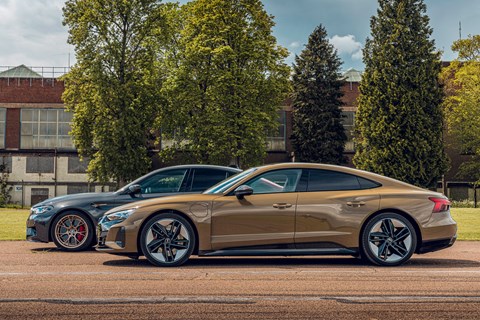
All-different, all-wheel drive
Both cars use active all-wheel drive to put their enormous power down cleanly. The M5 CS is the most powerful production BMW ever, with 626bhp. But the all-electric Audi is more powerful still.
It uses two motors, the front capable of 235bhp and the rear 449bhp. If launch control is deployed, a two-speed gearbox with a short first gear helps the rear motor from standstill. The motor, power electronics and transmission form one neatly packaged block at each axle. RS versions also get a diff lock at the rear.
Four separate cooling circuits are required for the running gear and interior. The M5 makes do with massive grilles. In Efficiency mode, the e-Tron becomes front-wheel drive but in other modes the torque is varied continuously between front and rear.
The BMW also constantly controls torque split: front to rear by a transfer case, and side to side to the rear wheels by an electronic active diff. But the M5 can be put into pure rear-drive mode too – at which point the traction control is fully switched off. Save it for the track – it’s really quite lively…
Socket to M!
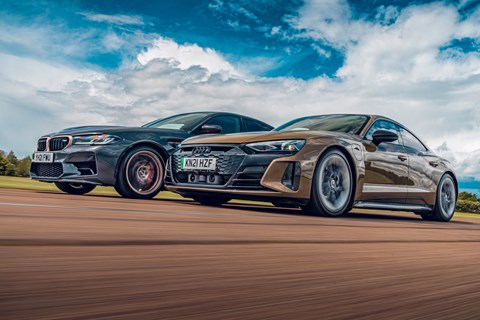
This is normally the grace period; the opening miles of a journey, where you wait for the fluids in the car’s mechanical belly to warm up; wait for the climate control to get the cabin appreciably warmer than the nippy early-morning air outside; wait for the caffeine of the second coffee to get to work. Then, and only then, when warm-up (literal and figurative) is complete, do you put your foot down.
But I can’t help myself. I climbed into the RS e-Tron GT for the first time only a few moments ago and I’ve just turned out of a junction onto a deserted, arrow-straight stretch. The Audi does have plenty of delicate moving parts, of course, but the fact there’s no engine under the bonnet makes the temptation to bypass mechanical sympathy too great. I take a deep breath and mash the throttle, no, gas, sorry, accelerator to the stop. And the result is… explosive and physically punishing, but curiously undramatic.
It’s fast – definitely fast. The horizon’s a lot closer than it was a moment ago and my stomach feels a bit weird, like it does after a fairground ride, but there’s a cushioned edge to the e-Tron’s power delivery. When its two motors are giving their all this is a 637bhp/612lb ft car but it’s not a savage experience; more like the sustained, unrelenting shove of a passenger jet on take-off.
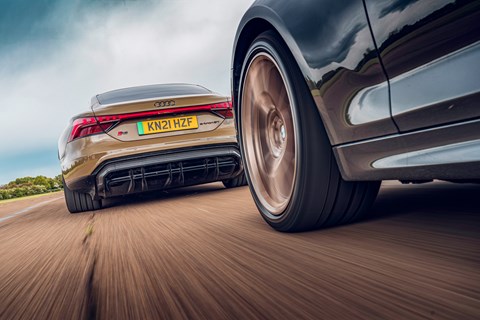
It’s propelling us to a rendezvous with the new CS version of BMW’s mighty M5, and depending on your standpoint that lack of drama could be an issue or a virtue because the gold-trimmed CS enters the world stage (sideways) as the most flamboyant super-saloon on sale today. There are plenty of differences between these two: the Audi is a slinky fastback, the BMW a saloon. The Audi is positioned as a velvet-glove grand tourer with iron-fist performance, where the M5 CS is more of a Nürburgring warrior with knuckle-duster performance. And, of course, one is a pure EV and the other couldn’t be more petrol-powered if it had an extra jerry can in the boot.
But they have as much in common as divides them: four doors, four seats, huge power, a premium badge, performance all-wheel drive, active drivetrain technology and a price comfortably into six figures. The £112k RS (£135k as tested) is potent and desirable enough to be judged not only as an EV but as a desirable performance car in its own right – and there’s no benchmark like an M5. And on the flipside, the £140k M5 CS ought to feel as special as the starship Audi to justify an even higher price.
This two-world collision also feels like a moment in automotive time. Of the three traditional premium German performance arms (AMG, Audi Sport and BMW M), it’s Audi (with a little help from Porsche) that has gone all-electric first. The e-Tron GT is the first electric Audi to wear an RS badge, and although it shares a great deal of its DNA with the Porsche Taycan, it’s very much its own character in look, feel and approach. It’s the beginning of a new electrified direction for the RS brand, while the M5 CS is the ultimate culmination of M’s petrol super-saloon formula. The next M5, due in three years or so is, expected to be either plug-in hybrid or all-electric (with as much as 1000bhp). Just how high does this CS set the bar for that future M5 – and has Audi already surpassed it?

So far on this journey, the RS e-Tron GT has been a mixed bag. Front-end grip is relentless, and the power steering feels ever more responsive and accurate with speed, helped by the all-wheel steering system fitted to this Carbon Vorsprung version. It’s not a silent experience either, because synthesised sound matched to speed and load lends the car an engine-like voice: rumbly like a V8 in its sportier modes, and more subtle in its standard settings. An external speaker makes it audible to pedestrians and while stationary it even idles like an engine, a kind of low-level, slightly malevolent hum. Sounds cheesy on paper but appropriate in real life – it matches the GT’s muscular appearance, and gives sensory context to the speed you’re travelling at.
Unfortunately it’s not the only accompaniment to the drive. Turn down the powerful audio and you can hear squeaks and rattles from interior trim on bumpy roads. There are other weaknesses too. The downside of the zero-kickback, point-and-go steering is that it has very little feel and feedback, and it feels disconcertingly light at low speeds. Feel through the brake pedal is inconsistent, partly because the first 0.3g of deceleration is taken care of by the motors – the RS’s tungsten-carbide-coated discs don’t get involved until you brake more firmly. On the upside, because the motor energy recuperation happens when you press the brake pedal rather than when you lift off the gas (sorry, accelerator), it feels safer to drive quickly than, for example, a Tesla Model 3, because weight transfer is more even.
But the RS e-Tron’s biggest weakness is that lack of drama: it’s somehow not as exciting to drive as it looks from the outside. You feel a stage or two removed from the road, like your job is to turn the steering wheel and play with the infotainment rather than to make a meaningful difference to the way the car gets down the road. That’s not to say you don’t feel the road; despite standard-fit adaptive air suspension on the RS version there’s a slightly brittle edge to the ride on this car’s optional 21-inch wheels, and potholes are to be especially avoided in Efficiency mode, which sinks the car floorwards by 22mm to reduce aerodynamic drag.
The e-Tron GT looks intensely purposeful in its most floor-hugging stance. But as we glide to a halt at our meeting point, a small but tricky test circuit in Oxfordshire, the M5 CS facing us looks even more so. It’s the first time the CS badge has been applied to the M5, and it follows a similar approach to that of the M2, M3 and M4 CS models: more power, more money, more grip, less weight (see panel for details). Its carbon-ceramic brakes are enormous. If the rear discs look unfeasibly large, the front calipers barely clear the wheels. It feels an appropriate metaphor for the car itself – the product of an enthusiastic engineering team pushing, pushing, pushing at tolerances and envelopes.
Climb in and you find yourself cradled in a deeply bowled carbonfibre shell with fantastically comfortable leather cushioning, and individual channels for your legs. Between the seats is a central carbonfibre moulding that makes you think you should be reaching up and clicking an Alton Towers-style restraint down into place, rather than reaching over your shoulder for a seatbelt. The rear seats are two individual buckets – the better for support if the driver is pressing on (and, amusingly, they include child seat mounts). Compared with the Audi it’s dated and gaudy (Nürburgring outline perforated into the headrests, anyone?) but if anything with an even tighter level of fit and finish. And more character; the e-Tron GT’s curiously staid cabin feels more like an upmarket saloon than a sporting GT.
The M5’s driving experience more than lives up to the promise of the OTT interior and XXL braking gear. This is a big, extrovert plaything. Steering, like the Audi, isn’t big on feel but is big on response. You don’t need much lock to introduce the CS to an apex; nor do you need worry about understeer. This car has a front axle that just doesn’t quit. The soft Pirelli P Zero Corsas (standard fit on the CS, and the tyre the suspension has been developed around specifically) sink their teeth into the tarmac like a vampire bat. Once the front end’s bitten, you can drive the rest of the car around on the throttle: in 4WD Sport mode, the stability control relaxes to give you just enough movement to rotate the car nicely and ride out the power with a hint of oversteer. On corner exit, it actually feels curiously similar to the e-Tron GT: the briefest blip of wheelspin followed by buckets of traction and a flat torque curve for relentless acceleration.
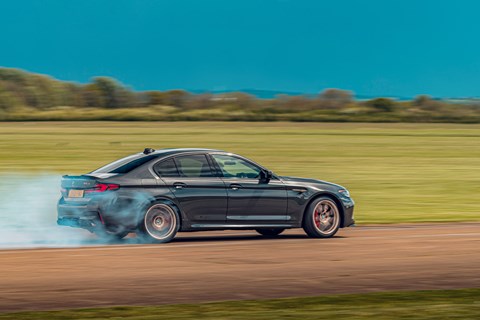
In both cars, the epic straight-line pace ceases to have meaning after a while. But where the M5 CS resensitises you is in its eagerness to corner. In fully rear-driven 2WD mode, the long wheelbase and quick steering make the CS as confidence-inspiring as you could ever hope for. If you want to make big smoke and look out of the side windows, it’s as keen as you are to indulge. And if you want to lap neatly, its braking power and the faithful consistency of its feedback make it equally rewarding.
Switching to the Audi on the circuit is underwhelming after the track-honed CS; it’s a road car with the capacity for wafty cruising as well as outright performance. But the circuit allows us to explore the outer envelope of the GT’s handling safely. What we find is a car with huge traction and a modicum of mid-corner adjustability. When it starts to rain – hard – the RS proves safe and predictable to slide around, and the outer limits of its handling are well contained and controlled. But with such light steering, you don’t feel all that much involvement in the corners. You could aim the same criticisms at the RS e-Tron GT as some petrol RS models: numb steering and a nose-led handling bias. It’s less predictable than the BMW but then it is a car with half a tonne more to carry, and said load is carried by variable-height air suspension, not a circuit-polished set-up like the M5 CS.
We venture out onto the road in the BMW, and find you rarely trouble its limits because they’re simply so high. But because its overall poise is so satisfying, and there’s a nicely judged level of feel through the controls, you still glean much of the same enjoyment at sensible speeds. And ride quality, while firmer than the Audi and a tad busy in the adaptive dampers’ sportiest setting, is easily tolerable for regular roads.
RS e-Tron vs M5 CS: verdict
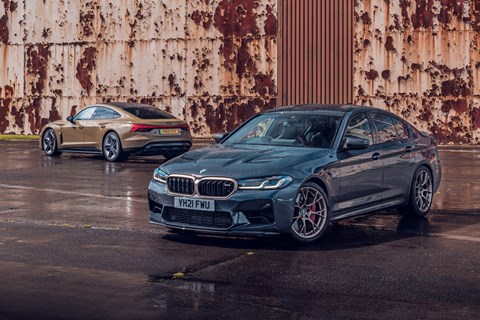
This is a snapshot of two cars at different stages of their evolution. The Audi e-Tron GT is a car at the beginning of a journey. While the Q4 e-Tron you’ll read about in a couple of pages’ time is the mainstream electric model Audi plans to sell a blue million of, the e-Tron GT’s job is to be the sexbomb flagship to sprinkle a bit of stardust on the e-Tron brand.
But in RS trim it feels like a between-two-stools sort of car. It’s fast and it’s alluring but to drive, and to sit in, it lacks the sense of occasion its expressive exterior promises. It’s refined and relaxing but feels more like a smart saloon than a dramatic GT. The M5 CS is the ultimate extrapolation of a car that’s been around for years, standing on the shoulders of decades of development work. It’s gauche and excessive but it’s a driving experience that stays with you longer, even if its format won’t.
If the next M5 will be all-electric, the challenge will be to imbue it with some of the same magic as the CS, so that it’s as memorable when the road gets wiggly as it is in a straight line.
First place: BMW M5 CS
Second place: Audi RS e-Tron GT
Read more CAR comparison tests here